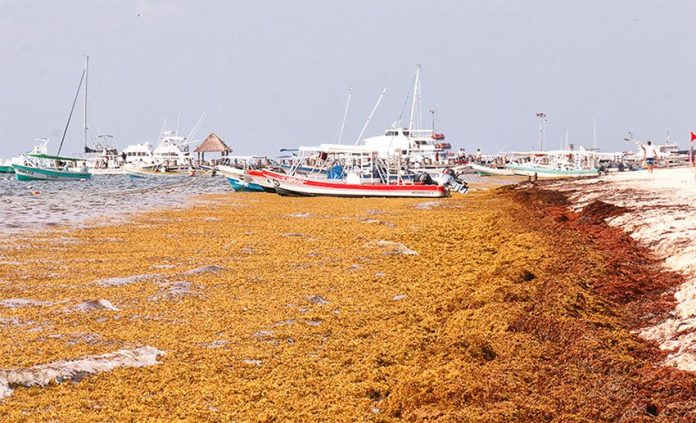“Sargassum is not a very serious issue,” President López Obrador said late last month but statistics – and some interesting analogies – paint a very different picture.
Almost 650,000 tonnes of the unsightly seaweed invaded the Quintana Roo coastline between the start of the year and June 24, the day the president made his questionable claim.
To help readers visualize such a massive amount of sargassum, the newspaper El Financiero explained that the weight is equal to that of 22,413 carriages of a passenger railway such as the Maya Train, which will one day make stops in Caribbean coast locations plagued by the smelly weed.
Another statistic that defies the logic of López Obrador’s assertion is that around 1,000 tonnes of seaweed are collected from Quintana Roo beaches every day during the sargassum season, which runs for several months.
Need some help imagining that quantity of malodorous macroalgae? Think Volkswagen Beetles – 1,351 of the iconic cars weigh the same amount.
Looking at those statistics, it’s not hard to work out who’s winning the ongoing sargassum battle. Hint: it’s not the authorities or hotel owners of Quintana Roo.
In fact, since López Obrador put the navy in charge of combatting the sargassum problem in the middle of May, it has collected just 155 tonnes of the seaweed at sea.
In other words, the navy’s effectiveness in preventing sargassum from reaching the coastline has been minimal at best. It has removed an average of 2.5 to 3 tonnes of seaweed from the ocean per day, a tiny fraction of the amount that has been picked up on shore.
The navy will likely improve its collection rate with specially-designed boats: it is building sargassum-gathering vessels but they won’t be ready for use until after this year’s sargassum invasion is over.
The federal and Quintana Roo governments are both throwing money at the problem: the former has allocated 52 million pesos while the latter will cough up 180 million pesos this year.
But it evidently isn’t enough. Hotel owners have been critical of the government’s response and many have put their hands into their own pockets to deal with the problem, some to the tune of as much as 8 million pesos a month.

But no matter how much money is forked out, the sargassum keeps coming.
Esteban Amaro, chief of the Cancún sargassum monitoring network, acknowledged that the statistics to June 24 are alarming but warned that they will rise significantly because July and August are the worst months of the year for the seasonal phenomenon.
The coast of the southern half of Quintana Roo has been especially hard hit in recent weeks but now more northern parts of the state are also seeing large amounts of sargassum.
Practically all of the Riviera Maya is currently affected by “abundant” levels of seaweed including Puerto Morelos and beaches at the Moon Palace resort, located just south of Cancún, although Playa del Carmen and Playacar were rated as moderate in today’s report by the network.
The east coast of Cozumel is still affected by “excessive” amounts, as are beaches in Tulum, Akumal, Bahía Príncipe and Xpu-Ha.
While the unwanted seaweed continues to wash up on beaches in greater and greater quantities, the arrival of much-needed international tourists is on the wane.
According to statistics supplied by hotels, reservations are down by up to 30%, and a lack of foreign visitors rather than holidaying Mexicans is mainly responsible for the decline.
The impact on the economy of the tourism-dependent state could be devastating.
Half of Cancún’s GDP is generated by tourism-related activities, according to the World Travel and Tourism Council, a figure that is higher than that of any other city in the world.
While the presence of sargassum is undoubtedly a deterrent to potential visitors, an analyst at the Monex financial group believes that the disbandment of the Tourism Promotion Council and consequent lack of marketing is the main reason behind the expected downturn in international arrivals.
“While we might see an impact on international passenger traffic because of sargassum, we believe that that the main impact comes from less tourism promotion . . .” Brian Rodríguez Ontiveros said.
Among people who haven’t been deterred from visiting Quintana Roo, the popularity of excursions to cenotes, or sinkholes, and archaeological sites has increased, tour operators say.
Manuel Paredes Mendoza, executive director of the Riviera Maya Hotel Association, recently said that hotels are now offering guests options to partake in 160 different tourist-oriented activities and excursions that are not centered on the state’s famous beaches.
He also said that hotel owners in the Riviera Maya are planning to transfer guests to properties with sargassum-free beaches so they can enjoy the white sands and turquoise waters for which the region is renowned.
Source: El Financiero (sp), El Economista (sp), Milenio (sp)
